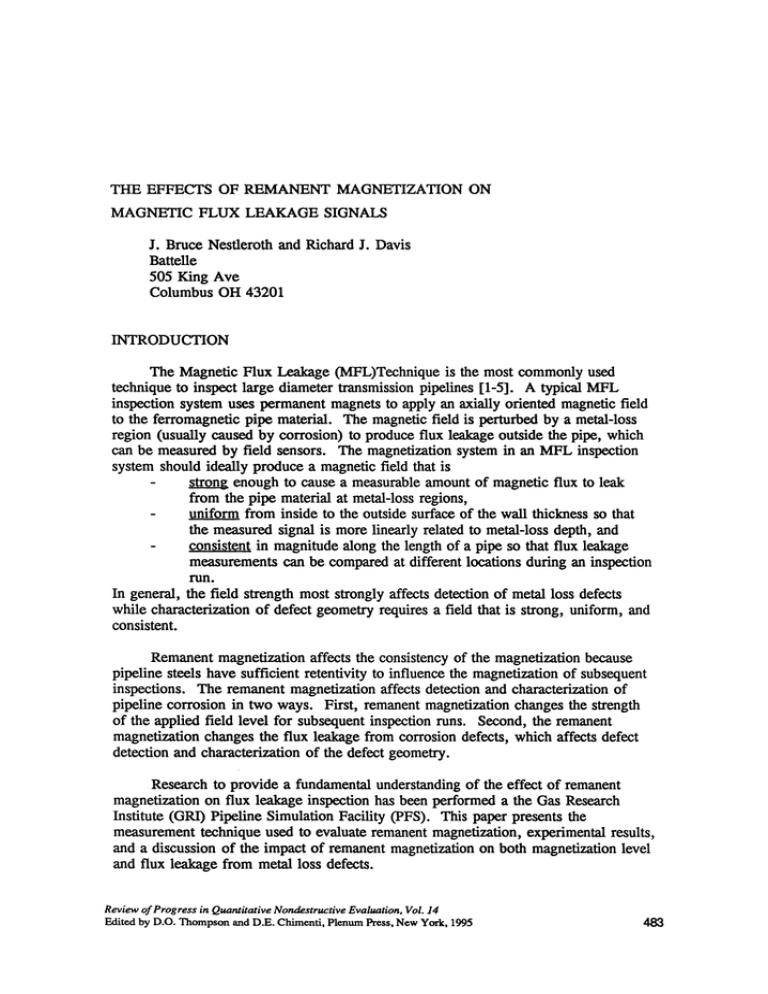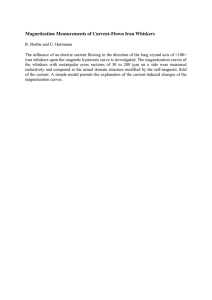The Effects of Remanent Magnetization on Magnetic Flux Leakage
advertisement

THE EFFECTS OF REMANENT MAGNETIZATION ON MAGNETIC FLUX LEAKAGE SIGNALS J. Bruce Nestleroth and Richard J. Davis Battelle 505 King Ave Columbus OR 43201 INTRODUCTION The Magnetic Flux Leakage (MFL)Technique is the most commonly used technique to inspect large diameter transmission pipelines [1-5]. A typical MFL inspection system uses permanent magnets to apply an axially oriented magnetic field to the ferromagnetic pipe material. The magnetic field is perturbed by a metal-loss region (usually caused by corrosion) to produce flux leakage outside the pipe, which can be measured by field sensors. The magnetization system in an MFL inspection system should ideally produce a magnetic field that is strong enough to cause a measurable amount of magnetic flux to leak from the pipe material at metal-loss regions, uniform from inside to the outside surface of the wall thickness so that the measured signal is more linearly related to metal-loss depth, and consistent in magnitude along the length of a pipe so that flux leakage measurements can be compared at different locations during an inspection run. In general, the field strength most strongly affects detection of metal loss defects while characterization of defect geometry requires a field that is strong, uniform, and consistent. Remanent magnetization affects the consistency of the magnetization because pipeline steels have sufficient retentivity to influence the magnetization of subsequent inspections. The remanent magnetization affects detection and characterization of pipeline corrosion in two ways. First, remanent magnetization changes the strength of the applied field level for subsequent inspection runs. Second, the remanent magnetization changes the flux leakage from corrosion defects, which affects defect detection and characterization of the defect geometry. Research to provide a fundamental understanding of the effect of remanent magnetization on flux leakage inspection has been performed a the Gas Research Institute (GR!) Pipeline Simulation Facility (PFS). This paper presents the measurement technique used to evaluate remanent magnetization, experimental results, and a discussion of the impact of remanent magnetization on both magnetization level and flux leakage from metal loss defects. Review of Progress in Quantitative Nondestructive Evaluation. Vol. 14 Edited by D.O. Thompson and D.E. Chimenti. Plenum Press. New York. 1995 483 MAGNETIZATION MEASUREMENT TECHNIQUE To evaluate the effect of remanent magnetization on MFL inspection of pipelines, the magnetization curve for a MFL magnetizer passing an axial distance in the pipeline was measured. This involves measuring the magnetic field H and the flux density B. Special instrumentation was developed, which includes two types of sensors, illustrated in Figure 1, to measure B and H [6]. The first sensor consists of a coil of wire wrapped through two small holes placed in the pipe with suitable precautions taken so that the windings are not destroyed by the passage of an MFL internal inspection device. The voltage across the coil is proportional to the time derivative of the flux density, and an integrator is used to convert the derivative to the flux density value. The magnetic field is measured with Hall elements mounted as close to the outside pipe surface as possible, since the tangential component of the magnetic field H is continuous across a boundary of two media. Each sensor pair (coil and Hall element) is mounted on a small circuit board that performs the necessary preamplification and integration and provides output signals proportional to magnetic flux density and field strength. By digitizing these values as the tool or test bed vehicle passes, the degree of pipe magnetization, the flux density, and the remanent magnetization can be determined. These data can be used to assess the effects of various magnet strengths, MFL inspection velocity, and pipe stress in the case of the flow loop. Each sensor pair measures the magnetization over a one-inch section of the pipe circumference. THE MAGNETIZATION PROCESS Pipeline steels exhibit a hysteresis effect when magnetized; specifically, when the applied field is removed, a flux density is left in the pipe. When the magnetic field is reapplied, the magnetization curve starts at an applied magnetic field equal to zero and a flux density equal to the remanent flux density. Hence, a new magnetization curve is generated. Therefore, magnetization curves are not only nonlinear, they are also different for repeated magnetizations. B Flux H Field Hall Generator Figure 1. Sensors for measuring magnetization curve. 484 + CD ~ "iii c::: Q) Cl X ::J u::: 0 u ~ c::: OJ CIl ::2i: o CJ:! + Magnetic Field Strength H , r!d Sensor Position .! ~~ --! A , B c D F Sensor Position Figure 2. Schematic explanation of the magnetization curve. 485 For internal MFL inspection of pipelines, most systems use permanent magnets. The magnetization process is shown schematically in Figure 2. A magnetic field sensor and a flux density sensor are fixed at one location of the pipe. The magnetization curve in Figure 2 starts at the origin, which means the pipe has no previous magnetic inspections or that it has been demagnetized. The curve moves through the following points: Position A: As the magnetizing assembly approaches, a negative magnetic field and flux density are produced due to air-coupled fields. Position B: As the forward leg of the magnet passes the sensor location, the applied field changes orientation and increases significantly. Position C: The maximum field intensity is achieved when the sensor is between the pole pieces, although not necessarily at the half way point. Position P: As the trailing leg of the magnet passes the sensor location, the field decreases significantly and changes orientation. Position E: The applied field reaches a maximum negative value before the magnetizing assembly leaves the sensor region. Position F: The applied field now is zero but some flux density remains in the pipe. This remaining flux density is the remanent magnetization. MAGNETIZATION LEVEL EXPERIMENTS The effects of multiple passes on the applied field can be seen in a measurement program using an instrumented pipe without metal-loss regions. Selected results from the instrumented measurements are shown in Figure 3. Subsequent passages of a magnetizing assembly created different magnetization curves. Two important changes ... 20 r---------~--~~--~--~--~--~~--~--~----~ Flow Loop Pipe 15 ...... : ...... : ...... :....... :.......:.................... ~,.~!iI!J.,~~!~ ...-.:... : ...... ~ ..... . 0.344 X70 ·, · • • ., . • • .. . • • .. . • • .. . I • • I .. . .. . • • • • 10 ...... ~ ...... ~ ..... .;...... .;.......;. ......... . · . : : : • .. . • • • • I • • 5 ..5 .. -... ~ ...... ~ ... -.. ~ .. _... ;....... :....... . -10 ...... ~ ...... ~ ...... ~ ...... :.......:........ . • I -15 • , • • • • : : : : : : ...... : ...... : ...... ;....... :: • • : I • : . . ...;.............;...... ; ...... ; .. . ··, ·· .. . . . , . . , . . , .., -1stRun ---2nd Run .-.. - ... 3rd Run - - -4th Run ----- 5th Run -20~------------~------------~------~--~------~~ -70 -60 -50 -40 -30 -20 -10 0 10 20 30 40 50 60 Magnetic Field H (Oersteds) Figure 3. Measured magnetization curves for repeated passages of an MFL tool. 486 70 can be observed. First, the maximum field and flux density are less for each passage. Second, these reductions of field level become less significant after the first passage and the level asymptotically approaches a final level. Remanent magnetization can affect inspection results by reducing flux density levels in the base material. For these experimental results, even though the magnetization field levels were significantly reduced, the flux density levels did not vary significantly because the pipe wall was saturated. For lower applied field levels, the effect on flux density would be greater, as shown schematically in Figure 4. Also, because remanent magnetization changes the applied flux levels, it also affects the flux leakage field and the ability to detect and characterize metal loss. The amount of remanent magnetization is dependent on design of the magnetization system. Many magnetization systems are taking advantage of rare earth permanent magnets that produce high magnetic flux density levels and relatively large remanent magnetization levels, which can produce high levels of residual magnetization. The key to reducing the effects of remanent magnetization is minimizing the shunting of magnetic flux at the leading and trailing pole pieces, illustrated in Figure 2. Along with affecting nondestructive testing technique, remanent magnetization can affect maintenance and repair operations. For example, welding to a pipeline with a strong residual magnetic field can be quite difficult. For Weak Applied Fields For Strong Applied Fields 1 -----+---------~--------------- 43 - ---- - -- - - --- -, CO _ Resultant decrease: in the flux density ; due to remanent magnetization 2 : : "00 C ote: Remanent magnetization effects reach a limtt aiter 3"5 magnetizations Q) o ir~A'~'"'. oX Q), Resultant decrease :::J u:::() :a; density results in a in the flux density in the pipe, Similar results for thick wall, other C Cl <U ~ ; Decrease in applied : : field due to remanent : magnetization, .. : Applied Magnetic Field Strength H Decrease in applied ; field due to remanent; ,- magnetization. Applied Magnetic Field Strength H Figure 4. Remanent magnetization effects on flux leakage. 487 ANALYSIS OF DEFECT SIGNALS Remanent magnetization also affects detection and characterization of metal loss defects. The MFL Test Bed Vehicle, a 128 channel MFL Data acquisition platform, was used to collect data to quantify the effect of remanent magnetization on defects. Figure 5 shows the test bed vehicle data recorded during the initial magnetization of the PSF Pull Rig defect set [6]. Figure 6 shows the test bed vehicle data recorded during the fourth magnetization of the pull rig defect set. In these figures, the gains and gray scales were held constant. Note that the magnetization level drops and signal levels are reduced. The signals at bottom of each figure quantify this effect. Marker A, the first vertical measurement line, indicates the base magnetization value is 542 for the initial case and 557 for the fourth magnetization. The raw test bed vehicle data is inverted and offset, with a value of 1024 equal to zero gauss, and a value of zero equal to maximum signal level with each digitation level equaling 0.64 gauss. This change in magnetization level is equal to 10 gauss (15 digital levels x 0.64 gauss per level). The signal amplitude changed more dramatically, as indicated by the difference between the Marker A and Marker B, the second vertical measurement line, which was 204 for the initial magnetization and 169 for the fourth for a 22 gauss change. The effect of remanent magnetization is a function of defect geometry. The normalized peak amplitudes from four simulated metal loss corrosion defects for the four consecutive magnetizations of the samples are shown in Figure 7. The results show that for defects that are larger (circumferentially wider and radially deeper), the defect amplitudes have a large initial drop in amplitude and then level off. However for defects that are smaller (narrower and shallower), the amplitudes follow a more gradual path to a nominal value. The axial length of the defect does not seem to have a significant effect on signal change. CONCLUSIONS Remanent magnetization affects detection and characterization of pipeline corrosion in two ways. First, remanent magnetization changes the strength of the applied field level for subsequent inspection runs. Second, the remanent magnetization changes the flux leakage from corrosion defects, which affects defect detection and characterization of the defect geometry. Experiment results obtained from the Gas Research Institute's (GRI) Pipeline Simulation Facility (pSF) show the effect of repeated experiments. Understanding the effect of remanent magnetization on signals from volumetric defects will help in the development of compensation functions to correct signals for inspection variables and constraints. Compensation functions take information on inspection variables (such as remanent magnetization, velocity, or material changes) and recorded signals, and outputs a signal corrected to a baseline signal that would have been detected if the signals were not changed by the operation variables. Then the corrected signals will be used to estimate defect geometry. This will provide the basis for improved inspection technology for transmission pipeline industry. ACKNOWLEDGEMENTS The research for this paper was funded by the Gas Research Institute using the NDE Laboratory of the GRI Pipeline Simulation Facility. 488 Figure 5. Test bed vehicle data from initial magnetization of pull rig defect set. Figure 6. Test bed vehicle data after fourth magnetization of pull rig defect set. 489 100% r-~~--------------~----------------------------------, • 1" Long, 6" Wide, 80"10 Deep + 1" Long, 1" Wide, 80"10 Deep > <> 3" Long, 3" Wide, 80"10 Deep ·c "" .0. 3" Long, 3" Wide, 20"10 Deep Q) :::J (ij (ij -... '0 90% c: Q) 0 Q) e::. Q) "0 :::J ~ a. E « (ij c: C> i:I.i 80% ... ~ ............................~;-. -....-...-....-...-... -....-=... ~. . .=-.- - - - . i N c: ~ c: ~ ~ ~ ~ i5c: :aic: '" '" c: 0 N c: Cl '" 0 N Cl 0 N Cl ::!: ::!: ::!: 70% ~~----------------~--------------~--------------~--~ Figure 7. The effect of remanent magnetization on flux leakage signals from volumetric defects. REFERENCES 1. 2. 3. 4. 5. 6. 490 T. A. Bubenik and J. B. Nestleroth, "Magnetic Flux Leakage (MFL) Technology for Natural Gas Pipeline Inspection," GR! Report 9110367, 1992. C. Bal, "The Latest Developments in Magnetic Flux Pigs," Pipes & Pipelines International, September-October 1991, pp 24-26. D. L. Atherton, "Magnetic Inspection is Key to Ensuring Safe Pipelines," Oil and Gas Journal, August 7, 1989, pp 52-61. R. W. E. Shannon and L. Jackson, "Flux Leakage Testing Applied to Operational Pipelines," Materials Evaluation, Vol. 46, No. 12, November 1988, pp 1516-1524. A. Teitsma, P. Porter, H. A. French and D. L. Atherton, "Recent Developments in Corrosion Detection," Proc. Int. Conference on Pipeline Inspection, June 1983, pp 445-471. R.J. Biber, et. al., "GR! Nondestructive Evaluation Program: Pipeline Simulation Facility Development", Gas Research Institute Annual Report, GR!92/0141, December 1991.







